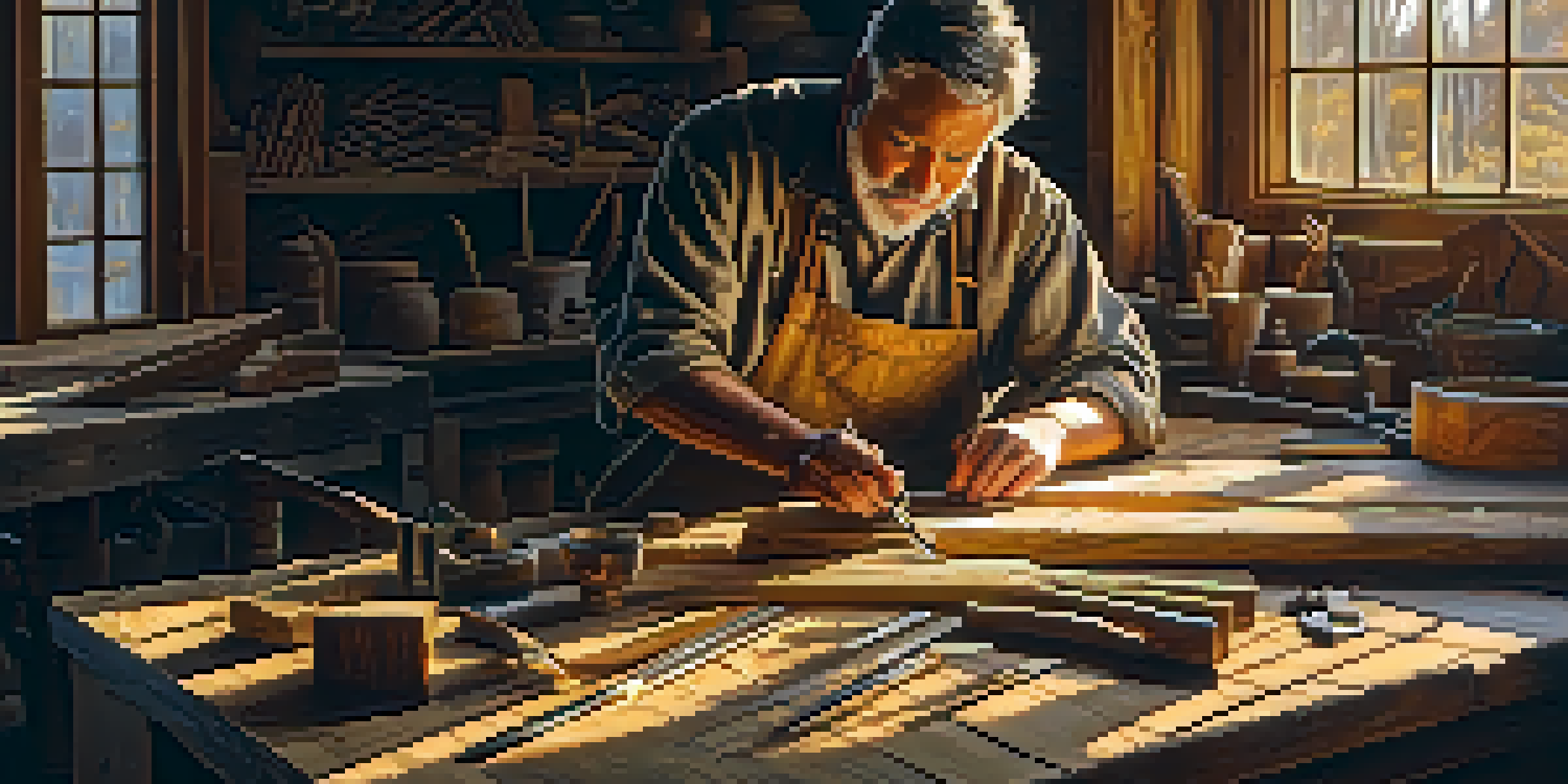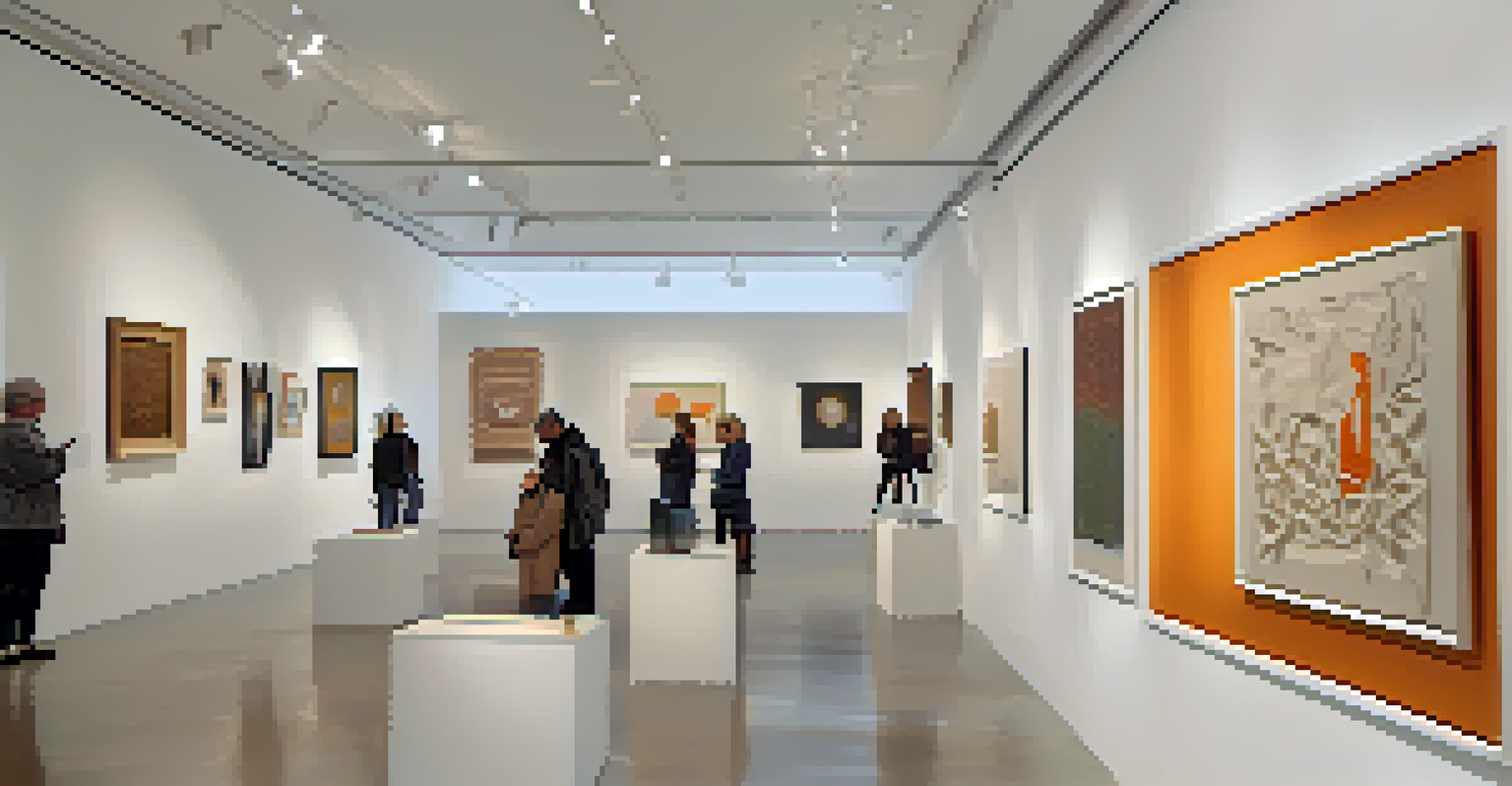The Evolution of Carving as a Medium for Self-Expression

The Origins of Carving: A Practical Necessity
Carving has been a vital skill since ancient times, primarily for practical purposes. Early humans carved wood and bone to create tools, weapons, and utensils, essential for survival. This utilitarian approach laid the foundation for what would become a rich tradition of artistic expression.
Art is the most beautiful of all lies.
As societies evolved, the need for functional items expanded into artistic endeavors. Carving techniques were refined, allowing artisans to create intricate designs that reflected their culture. Tools and materials became more diverse, opening new avenues for creativity.
The shift from pure utility to artistry marked the beginning of carving as a medium for self-expression. What started as a necessity transformed into a canvas for individual identity, emotions, and beliefs, setting the stage for future developments in the craft.
Cultural Significance: Carving Across Civilizations
Throughout history, carving has played a significant role in various cultures around the globe. From the totem poles of Native American tribes to the intricate stone carvings of ancient Egypt, each piece tells a story. These carvings often held spiritual or cultural significance, serving as symbols of identity and tradition.

As different civilizations encountered one another, their carving styles influenced and inspired creativity. The exchange of ideas and techniques led to the blending of cultural motifs, enriching the art form. This dynamic interaction illustrates how carving has been a universal language of expression.
Carving: From Utility to Art
What began as a practical necessity has evolved into a rich medium for personal and cultural expression.
Today, many contemporary artists draw inspiration from these historical traditions while infusing their own narratives. This fusion of past and present showcases how carving continues to be a relevant medium for self-expression across cultures.
Technological Advances: Tools and Techniques
The evolution of carving tools has significantly impacted the craft, making it more accessible to artists. Traditional hand tools such as chisels and knives have now been supplemented with modern technology, including power tools and CNC machines. These advancements allow for greater precision and complexity in carving designs.
The artist is not a special kind of person; every person is a special kind of artist.
Moreover, the availability of diverse materials, like synthetic composites and reclaimed wood, has expanded creative possibilities. Artists now have a broader palette to choose from, enabling them to experiment with textures, shapes, and colors. This versatility encourages innovation and personal expression in carving.
As technology continues to advance, the boundaries of carving are pushed further. Artists can now combine traditional methods with digital design, leading to unique pieces that reflect modern sensibilities while honoring age-old techniques.
Carving as a Form of Personal Narrative
In recent years, carving has become a powerful tool for personal storytelling. Artists use their work to express their experiences, emotions, and perspectives, creating pieces that resonate deeply with viewers. This narrative aspect adds a layer of meaning, transforming carving from mere aesthetics to impactful communication.
For many, carving serves as a form of therapy or self-discovery. The physical act of carving can be meditative, allowing artists to channel their thoughts and feelings into their work. This connection between creator and creation fosters a profound sense of fulfillment and self-expression.
Cultural Exchange Through Carving
Carving serves as a universal language, reflecting the stories and identities of various civilizations throughout history.
As audiences engage with these personal narratives, they find themselves reflecting on their own stories. Carving becomes a bridge, connecting diverse experiences through shared emotions, thus enriching the collective understanding of human expression.
Modern Movements: New Voices in Carving
Contemporary carving has seen a surge of diverse voices contributing to the art form. Artists from various backgrounds are challenging traditional norms, exploring themes like identity, social justice, and environmental issues through their work. This evolution reflects a broader societal shift towards inclusivity and representation in the arts.
Exhibitions and galleries are increasingly showcasing these innovative works, sparking conversations about the role of carving in modern society. Collaborative projects and community workshops further emphasize the importance of collective expression, inviting individuals to share their perspectives through carving.
These modern movements highlight how carving as a medium has expanded beyond personal expression to address global themes. By fostering dialogue and understanding, contemporary carving continues to evolve in relevance and impact.
Environmental Considerations in Carving
As awareness of environmental issues grows, many carving artists are embracing sustainable practices. The choice of materials has become increasingly important, with a focus on sourcing ethically and using reclaimed wood. This commitment to sustainability not only benefits the planet but also enhances the narrative of the artwork.
Incorporating eco-friendly materials and techniques allows artists to communicate their values through their creations. Carving becomes a statement about respect for nature, urging viewers to consider their relationship with the environment. This deeper connection adds richness to the overall message of the artwork.
Sustainable Practices in Carving
Contemporary artists are prioritizing environmental considerations, using ethically sourced materials to enhance the narrative of their work.
By prioritizing environmental considerations, contemporary carving can inspire change and promote consciousness. Artists are not just expressing themselves; they are also advocating for a more sustainable future through their craft.
The Future of Carving: Trends and Innovations
Looking ahead, the future of carving is bright and full of potential. As new tools and technologies continue to emerge, artists will have even more avenues for creativity. Innovations in materials and techniques promise to reshape the landscape of carving, inviting fresh perspectives and ideas.
Moreover, the growing interest in tactile and handmade art forms suggests a resurgence of appreciation for traditional skills. In a world dominated by digital experiences, carving offers a tangible connection to creativity, allowing individuals to engage with art on a personal level.

As carving evolves, it will undoubtedly adapt to reflect the changing dynamics of society. This adaptability ensures that carving remains not only a medium for self-expression but also a vital part of cultural heritage and artistic exploration.